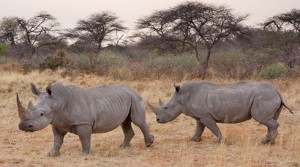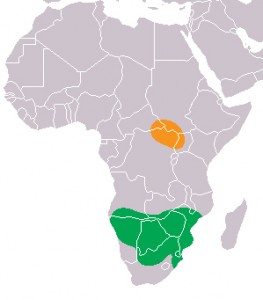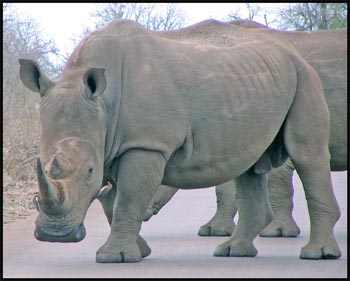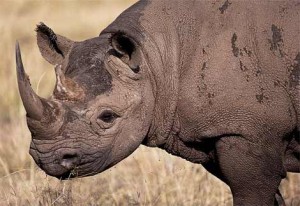
“There’s a new, living species of African rhino, bringing the recognized number of living rhino species to six….It was first named in 1908 and has previously been regarded (without exception) as a ‘subspecies.’
May 4, 2010

“There’s a new, living species of African rhino, bringing the recognized number of living rhino species to six….It was first named in 1908 and has previously been regarded (without exception) as a ‘subspecies.’
It’s the Northern or Cotton’s white rhinoceros (aka Grass rhino or Square-lipped rhino) Ceratotherium cottoni, previously classified as Ceratotherium simum cottoni, and first named by Richard Lydekker following its discovery in 1900*.”
So begins Darren Naish’s good new overview of the fact that there are now considered to be two white rhino species, not one species with merely two subspecies. This finding is groundbreaking news, as the actual numbers of both species are very low and this highlights the need for urgent conservation efforts.

The map illustrates the historical distribution of the two Ceratotherium taxa. C. cottoni’s range is shown in orange and C. simum’s in green.
This animal is a classic cryptozoological “animal of discovery,” from the Victorian era.
As Naish literally notes: “*Percy H. G. Powell-Cotton was the first person to bring Northern white rhinos to scientific attention: in 1900 he collected a specimen from the Lado District of South Sudan. Oldfield Thomas published on these discoveries in 1900, but it was Lydekker (1908) – well known for being a consummate splitter, though don’t let that put you off – who made the decision to name the northern rhino as a new subspecies. Lydekker used the name Rhinoceros simum cottoni: the generic name Ceratotherium had been coined by Gray in 1868, but the taxonomy of African rhinos was confused at this time (Rookmaaker 2005a).”
New animals are all about, and sometimes they are there, already discovered, if we merely look again.

An image of one of the two species of white rhino, showing the wide upper lip.

The African black rhino has a decidedly smaller mouth.
White Rhinoceros Name Trivia & Folklore:
A popular theory of the origin of the name White Rhinoceros is a mistranslation from Dutch to English.
The English word white in English is said to have been derived by a mistranslation of the Dutch word wijd, which means wide in English. The word wide refers to the width of the rhinoceros mouth (or in other versions, the upper lip).
As a result, early English-speaking settlers in South Africa misinterpreted the wijd for white. The rhino with the wide mouth resulted in being called the White Rhinoceros and the other one, with the narrow pointed mouth, was called the Black Rhinoceros. In other words, the use of the names had nothing to do with the colors of the animals.
Ironically, Dutch (and Afrikaans) later used a calque (an expression introduced into one language by translating it from another language) of the English word, and now also call it a white rhino. This suggests the word’s origin lies before codification by Dutch writers. A review of Dutch and Afrikaans literature about the rhinoceros has failed to produce any evidence that the word wijd was ever used to describe the rhino outside of oral utilization.
About Loren Coleman
Loren Coleman is one of the world’s leading cryptozoologists, some say “the” leading living cryptozoologist. Certainly, he is acknowledged as the current living American researcher and writer who has most popularized cryptozoology in the late 20th and early 21st centuries.
Starting his fieldwork and investigations in 1960, after traveling and trekking extensively in pursuit of cryptozoological mysteries, Coleman began writing to share his experiences in 1969. An honorary member of Ivan T. Sanderson’s Society for the Investigation of the Unexplained in the 1970s, Coleman has been bestowed with similar honorary memberships of the North Idaho College Cryptozoology Club in 1983, and in subsequent years, that of the British Columbia Scientific Cryptozoology Club, CryptoSafari International, and other international organizations. He was also a Life Member and Benefactor of the International Society of Cryptozoology (now-defunct).
Loren Coleman’s daily blog, as a member of the Cryptomundo Team, served as an ongoing avenue of communication for the ever-growing body of cryptozoo news from 2005 through 2013. He returned as an infrequent contributor beginning Halloween week of 2015.
Coleman is the founder in 2003, and current director of the International Cryptozoology Museum in Portland, Maine.
Filed under Breaking News, Classic Animals of Discovery, CryptoZoo News, Evidence, Forensic Science, Megafauna